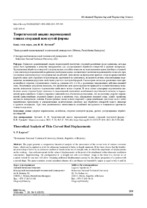Теоретический анализ перемещений тонких стержней изогнутой формы
Another Title
Theoretical Analysis of Thin Curved Rod Displacements
Bibliographic entry
Луговой, В. П. Теоретический анализ перемещений тонких стержней изогнутой формы = Theoretical Analysis of Thin Curved Rod Displacements / В. П. Луговой // Наука и техника. – 2021. – № 5. – С. 399-404.
Abstract
Приведен сравнительный анализ перемещений изогнутых стержней различных форм кривизны, которые могут быть применены в качестве инструментов для ультразвуковой обработки отверстий в хрупких материалах. Традиционная обработка отверстий ультразвуковым способом основана на использовании прямолинейных стержней: у них амплитуда перемещений на рабочем (свободном) конце соответствует величине перемещений в точке его присоединения к концентратору ультразвуковых колебаний. Дополнение конфигурации прямого стержня криволинейной формой в виде дуги окружности или спирали, скрученной на один виток, позволит получить дополнительные перемещения, вызванные упругими свойствами участка с изогнутой формой. Рассмотрено несколько расчетных схем криволинейного стержня, ограниченного углами ϕ, равными π/2, π и 2π, с различным направлением действия внешней силы. Полученные результаты показали, что увеличение угла дуги окружности приводит к соответствующему повышению показателя упругого перемещения свободного конца стержня. В этом случае суммарные перемещения свободного конца стержня будут слагаться из перемещений, вызванных колебаниями акустической системы, и перемещений криволинейного тонкого стержня от внешней силы. Расчетами установлено, что на величину упругих перемещений криволинейных стержней влияют форма и величина угла, направление внешней силы, радиус кривизны, жесткость поперечного сечения. Рассмотренные схемы тонких стержней с криволинейными участками могут найти практическое применение в ультразвуковых колебательных системах для обработки отверстий малого диаметра в хрупких материалах. При этом увеличивается интенсивность колебаний инструмента и повышается производительность процесса.
Abstract in another language
The paper presents a comparative theoretical analysis of the movements of the curved rods of various curvature forms, which can be applied as tools for ultrasonic treatment of holes in fragile materials. It has been shown that the traditional processing of holes by an ultrasonic method is based on the use of straight rods, in which the amplitudes of displacements on the working – free end corresponds to the value of displacements at the point of its attachment to the ultrasonic oscillation concentrator. Supplementing the configuration of a straight rod with a curvilinear shape in the form of a circular arc or a spiral twisted by one turn will allow obtaining additional displacements caused by the elastic properties of a section with a curved shape. The paper considers several calculated schemes of a curvilinear rod bounded by angles ϕ equal to π/2, π and 2π, with a different direction of the external force action. The obtained results have shown that an increase in the circular arc angle leads to a corresponding increase in the elastic displacement index of the rod free end. In this case, the total displacements of the rod free end will be made from displacements caused by vibrations of the acoustic system and the displacements of a curved thin rod from an external force. Calculations have established that the magnitude of the elastic displacements of curved rods is influenced by the shape and magnitude of the angle, the direction of the external force, the radius of curvature, the rigidity of the cross section. The considered schemes of thin rods with curvilinear sections can find practical application in ultrasonic oscillatory systems for processing small-diameter holes in fragile materials. This increases the intensity of tool oscillations and improves the process performance.
View/
Collections
- № 5[12]

